
Syntegra is a bogie developed by Siemens incorporating an axle mounted gearless electric drive in an inboard bogie.
Contents
The design was unveiled at Innotrans in 2006, and began service trials in 2008 on the Munich U-Bahn. [1] [2]

Syntegra is a bogie developed by Siemens incorporating an axle mounted gearless electric drive in an inboard bogie.
The design was unveiled at Innotrans in 2006, and began service trials in 2008 on the Munich U-Bahn. [1] [2]
The motor design is a hermetically sealed simple co-axial gearless synchronous motor (a permanent magnet, three phase drive, passively cooled design); the motors can also be used for electrical dynamic braking, and also as an active electric brake. [1] [3] The wheelset bearings are mounted inboard and support both motor, axles and wheel. A traction link from motor to the vehicle frame transmits tractive forces. [3]
The bogie frame has a single central cross member which supports via pivots two longitudinal beams (in a 'weighing scale' arrangement) connected to the wheelset via the primary suspension. [3] The cross member supports the vehicle body via the secondary suspension of two outboard air springs. [1]
In mid-2006 prototype motors rated 110 kilowatts (150 hp), with claimed 96% efficiency, were fitted to an ex-Munich U-Bahn vehicle for testing at the Wegberg-Wildenrath test circuit. [4] In 2008 a train fitted with two Syntegra bogies began in-service tests on the Munich U-Bahn. [5]
A 150 kilowatts (200 hp) prototype was displayed at Innotrans (2009), the prototype bogie weight was 5.6 tonnes (5.5 long tons; 6.2 short tons), with a 1.6-metre (63-inch) wheelbase and a maximum axleload of 14 tonnes (14 long tons; 15 short tons). [1]

HS4000 Kestrel was a prototype high-powered mainline diesel locomotive that was built in 1967 by Brush Traction, Loughborough, as a technology demonstrator for potential future British Rail and export orders. The locomotive number is a combination of the initials of Hawker Siddeley and the power rating of its Sulzer diesel engine (4,000 hp), making it the most powerful locomotive built by the company.
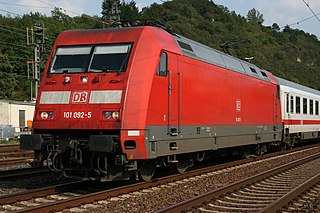
The DB Class 101 is a class of three-phase electric locomotives built by Adtranz and operated by DB Fernverkehr in Germany. 145 locomotives were built between 1996 and 1999 to replace the 30-year-old and aging Class 103 as the flagship of the Deutsche Bahn, primarily hauling Intercity services. This class encompasses the latest generation of locomotives of the Deutsche Bahn.
B-B and Bo-Bo are the Association of American Railroads (AAR) and British classifications of wheel arrangement for railway locomotives with four axles in two individual bogies. They are equivalent to the B′B′ and Bo′Bo′ classifications in the UIC system. The arrangement of two, two-axled, bogies is a common wheel arrangement for modern electric and diesel locomotives.

NSB Di 6, later designated ME 26 and DE 2700, is a class of twelve diesel-electric locomotives built by Siemens for the Norwegian State Railways (NSB). The prime mover provides a power output of 2,650 kilowatts (3,550 hp), a starting traction effort of 400 kilonewtons (90,000 lbf) and a maximum speed of 160 kilometres per hour (99 mph). They have a Co′Co′ wheel arrangement. The bidirectional locomotives were designed for use with both passenger and freight trains.
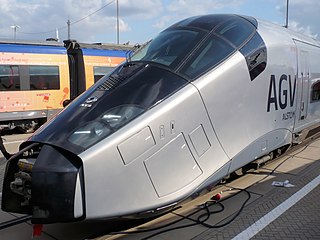
The AGV is a standard gauge, high-speed, electric multiple-unit train designed and built by Alstom.

A variable gauge system allows railway vehicles in a train to travel across a break of gauge between two railway networks with different track gauges. For through operation, a train must be equipped with special bogies holding variable gauge wheelsets which contain a variable gauge axle (VGA).
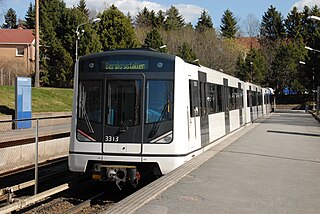
MX3000 is an electric train used on Oslo Metro in Oslo, Norway. The multiple units are produced by Siemens Mobility, who started serial delivery in 2007. Seventy-eight three-car units were ordered by Sporveien, and five by Akershus County Municipality. They replaced the older T1000 and T1300 stock that was used on the Oslo Metro since 1966. By 2010, the last T1000 and T1300 trains had been retired and replaced by 83 three-car units. 32 additional sets were ordered, and the final train set was delivered in 2014, increasing the fleet to 115 units.
Wheel slide protection and wheel slip protection are railway terms used to describe automatic systems used to detect and prevent wheel-slide during braking or wheel-slip during acceleration. This is analogous to ABS and traction control systems used on motor vehicles. It is particularly important in slippery rail conditions.

The EuroSprinter family of electric locomotives is a modular concept of locomotives for the European market built by Siemens Mobility. The internal Siemens product name is ES 64, with ES for EuroSprinter and the number 64 indicating the 6,400 kW power at rail.

The Eurorunner family of locomotives are a series of medium- to high-power diesel-electric locomotives built by Siemens for the European market. Introduced from 2002 onwards, they share design characteristics with the successful Eurosprinter range of electric locomotives, also built by Siemens.
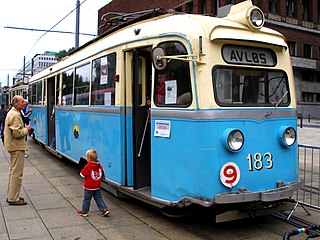
Class B and Class E, normally referred to as Gullfisk, were a class of 46 trams built by Strømmens Værksted and Skabo Jernbanevognfabrikk for Oslo Sporveier and Bærumsbanen of Oslo, Norway, in 1937 and 1939. They were the first aluminium trams to operate on the Oslo Tramway and the first bogie trams to operate on street lines. They had contemporary modern electronic equipment, a streamlined shape, and comfortable accommodation. Until 1964, they were also faster than any other Norwegian tramcar or suburban railcar.

128 001, as registered at Deutsche Bahn, or 12X, as named by its manufacturer AEG Schienenfahrzeuge and its successive owners ADtranz and Bombardier Transportation, is an experimental high-performance electric locomotive built in 1994, which was operated as testbed and test locomotive until 2010. The design of the locomotive featured several technological innovations, including power electronics using new types of semiconductors and water cooling, a new final drive concept, a new bogie concept, and protruding windflaps for improved aerodynamics that gave the locomotive a unique look.

The Rhaetian Railway Be 4/4 is a class of 11 kV 16.7 Hz AC metre gauge railcars operating under the traffic numbers 511–516 on the so-called core network of the Rhaetian Railway (RhB), which is the main railway network in the Canton of Graubünden, Switzerland.

The Bernina Railway Ge 6/6 81, later reclassified as Ge 4/4 81, and later still known as the Rhaetian Railway Ge 4/4 181, is a 1000 V DC metre gauge electrically powered heritage locomotive made in Switzerland.

The China Railways HXD1 is an eight axle high power heavy freight twin unit locomotive of axle configuration Bo'Bo'+Bo'Bo'. Both the HXD1 and HXD2 double unit locomotives were designated DJ4, the HXD2 units being disambiguated DJ4-6000.
Torque vectoring is a technology employed in automobile differentials that has the ability to vary the torque to each half-shaft with an electronic system; or in rail vehicles which achieve the same using individually motored wheels. This method of power transfer has recently become popular in all-wheel drive vehicles. Some newer front-wheel drive vehicles also have a basic torque vectoring differential. As technology in the automotive industry improves, more vehicles are equipped with torque vectoring differentials. This allows for the wheels to grip the road for better launch and handling.
The Heilmann locomotives were a series of three experimental steam-electric locomotives produced in the 1890s for the French Chemins de fer de l'Ouest. A prototype was built in 1894 and two larger locomotives were built in 1897. These locomotives used electric transmission, much like later-popular diesel-electric locomotives and various other self powered locomotives.

The GE PowerHaul is a class of mainline diesel-electric locomotives designed by General Electric. Thirty locomotives were ordered by Freightliner in 2007; the first locomotive was completed in July 2009 at GE's Erie, Pennsylvania, plant.

The VL85 is a Soviet built electric mainline freight locomotive manufactured at the Novocherkassk Electric Locomotive Plant (NEVZ) and designed under the management of V.Ya.Sverdlov (ru:В.Я.Свердлов).
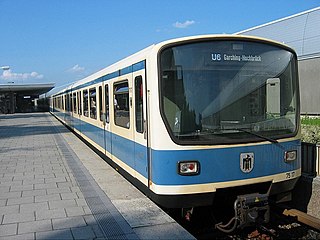
The MVG Class B is an electric multiple unit (EMU) train type operated by the Münchner Verkehrsgesellschaft on the Munich U-Bahn system. The prototypes were delivered in 1981, and the full-production units from 1987. A derivative of the Class B, the VAG Class DT2, is in service on the Nuremberg U-Bahn system.